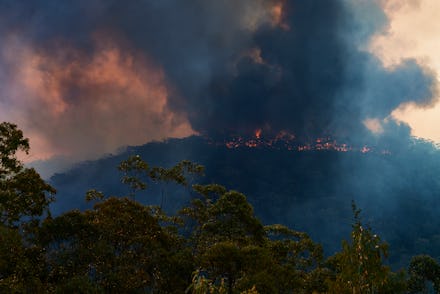Why does the whole world seem to be on fire?

Rampaging wildfires in Australia have reached the suburbs of Sydney, prompting officials to evacuate residents and tourists in some areas. Homes within the city, located in the state of New South Wales (NSW), are in danger due to the extremely fire-friendly conditions that have sparked fears of high winds blowing embers into people's backyards. The BBC reported at least 120 Australian bushfires burning in NSW and Queensland that have already destroyed over 200 homes, killed four people, injured 13 firefighters, and killed hundreds of koalas — and it doesn't look like they're stopping anytime soon.
"This is a very challenging season," said Greg Christensen, mayor for the Scenic Rim regional council in Queensland, to reporters. "You haven't had bushfires like these bushfires before."
Most residents have heeded the evacuation warnings early enough to prevent any further deaths from the uncontrollable flames. But humans aren't the only ones in danger; the koala population has suffered significantly from the wildfires as they burned through a major koala colony and threatened others. Hundreds of koalas have died, reported Australia's ABC News, and the survivors are relying on humans to mend their burns. The devastation from the fires could put the koala back on the endangered species list.
Human lives are also upended as residents continue to remain on notice about the wildfires. CBS News stated there were at least 600 schools and technical colleges closed due to their vicinity to the fire. Homes and vehicles have been doused with flame retardant as planes dropped them from above. At least 3,000 firefighters have mobilized to keep the fires at bay.
Shane Fitzsimmons, the Rural Fire Service Commissioner told reporters that he expects there will still be weeks of firefighting to do. "You can guarantee we're not going to be able to get around all of these fires before the next wave of bad weather."
Between hot temperatures, high winds, and 'dry thunder' threatening to cause more sparks, Australians are looking to have a long and smoke-filled summer. "Unfortunately, there's no meaningful reprieve," Fitzsimmons continued. "There's no rainfall in this change and we're going to continue to have warm dry conditions dominating in the days and weeks ahead."
It's not unusual for Australia to have hot summers, but the island country's fire season has started earlier than usual — something climate experts have warned about. The Australian government's Bureau of Meteorology has stated that climate change has increased the frequency and severity of major heat events like drought and heatwaves. The bureau also reported an 11 percent decline in rainfall during in southeast Australia since the late 1990s. "Australia will need to plan for and adapt to some level of climate change," the report concluded.
Australia joins other countries around the world that are facing longer wildfire seasons. Just this year, Brazil faced down an enormous fire that burned through over 2 million acres of Amazon rainforest, suspected to be caused by lax environmental protections and devastating agricultural practices that encourage deforestation. In Lebanon, heatwaves and strong winds created the country's worst wildfire in decades, putting thousands of residents at risk as the government struggled to fight the fires due to the lack of preparedness. Even before its biggest wildfire, the country had already lost 3 million trees from forest fires. Reporters noted that the number was equal to all the trees planted through reforestation projects within the past 15 years.
The United States did not go unscathed from the intense fire season, either. California was forced to stand against extreme weather conditions again this year, with the poor maintenance of utility lines and "violent winds" fueling flames that burned through over 16,000 acres in Sonoma County. Firefighters in southern France were battling wildfires, Russia's Siberian province was burning, and even areas within the Arctic circle weren't safe from the heat. For anyone keeping track, this year has seemed like a hell of a year for fires.
There were many factors scientists and experts pointed to that combined to create the best conditions for the worst wildfire devastation. Longer, hotter, and drier weather due to climate change provide the literal kindle for the flames. Australia has seen wildfires start as early as spring. California has seen wildfires last into November and December — a trend that the San Francisco Chronicle no longer considers uncommon.
Longer droughts and warmer weather can alter the natural environment. From here, human behavior can play a part in creating sparks. Some people have started fires, either through suspicious behavior, by accident or recklessness, or for agricultural purposes. Power lines that have not been maintained can ignite a wildfire. Land that was developed into a residential area can stunt any attempts at setting controlled fires for forest maintenance purposes.
Finally, governments and politicians continue to contribute to the growing number of wildfires. Even as Australia burns, the country's politicians have either argued whether climate change is to blame, have pointed fingers at environmentalists for the lack of forest management instead, or have declined to talk about climate change completely as the wildfires continue.
Scientists have been urging countries to recognize climate change as a factor in setting the stage for wildfires. Once it's acknowledged as a threat, researchers hope the science can help citizens understand what to expect and how to adjust. Communities can become better prepared to protect from the effects of a changing environment.
But climate change must be recognized, first.